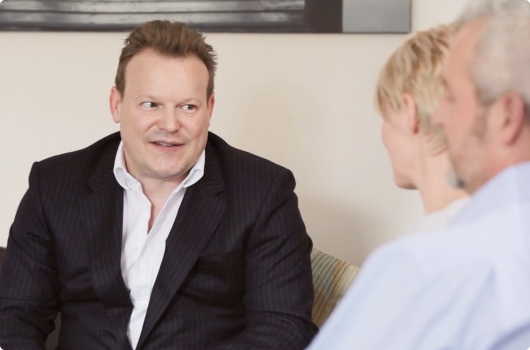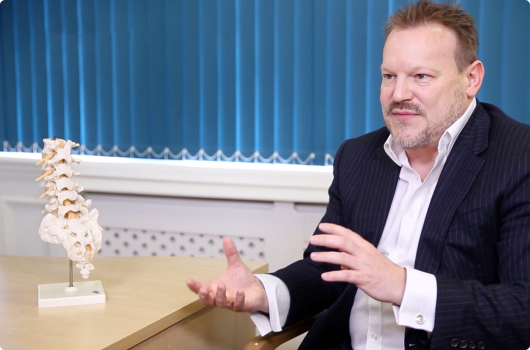Percutaneous Discectomy - Treatment for Herniated Discs
Searching for a revolutionary spinal care solution? Percutaneous discectomy stands out as the leading-edge procedure addressing herniation disc with minimal postoperative pain and length of hospital stay. Spine Art in Yarm brings this advanced treatment to patients across the Northeast including Cumbria, North Yorkshire, and South Yorkshire. This procedure uses precision techniques to remove herniated disc material, relieving pressure on spinal nerves. Our 25 years of experience underscores the proficiency and care we provide, ensuring minimal recovery time and enhanced mobility. Choose Spine Art for expert care and rapid access to state-of-the-art spinal treatments.
Book a consultation
What is Herniation Disc?
Herniation disc arises when the soft inner glycoprotein core of a spinal disc pushes through its tough outer layer (or annulus), leading to back pain, sciatica, and other symptoms. Each spinal disc cushions and supports the vertebrae during compressive forces but is weak in rotational force. A failure of the disc under load can cause a herniation or protrusion which can press on nearby nerves. This pressure causes inflammation of the nerve root with discomfort and mobility problems. Back pain may range from a dull ache to sharp, intense pain. Sciatica manifests as pain radiating down the leg, while numbness or weakness can affect the leg, making daily activities challenging. Understanding this condition aids in recognising the need for appropriate medical intervention.
What is Percutaneous Discectomy?
Percutaneous discectomy, performed through a small portal, uses a specialised probe called a spinewand, which generates a focal plasma field to vapourise herniated disc material and also shrink the remaining disc. This minimally invasive procedure reduces recovery time and preserves surrounding tissues. No incision or skin sutures are necessary, and the patient goes home the same day after a light anaesthetic or sedation. Success rates are an 80% chance of permanent improvement in symptoms whilst avoiding the risk of most complications. This minimal access surgery is now our first option for elite athletes with a quick return to sport. The low risk is a particularly useful benefit in older patients who might have medical problems and are not able to have open surgery.
Here are some of the different techniques of discectomy:
• Open Discectomy or Microdiscectomy— With this technique, surgeons extract disc fragments using precision instruments through a small incision and interspinous approach to the spinal canal. The nerve root is directly decompressed, and the disc protrusion removed. A microscope or other form of magnification can be used during the procedure. Patients normally go home the following day with a recovery time of six weeks. This technique is still suitable as a first line treatment for some patients.
• Automated Percutaneous Lumbar Discectomy (APLD) – This technique uses a mechanical device to suction out the herniated materials. It is effective in reducing nerve compression by precisely targeting the affected area of disc. APLD often results in reduced pain and improved mobility but appears to be less effective than percutaneous discectomy with a plasma wand or laser.
• Laser-Assisted Discectomy – Laser energy vaporises or shrinks the disc tissue. This technique is similar to our technique in approach but uses a different energy source.
Procedure and Recovery from Percutaneous Lumbar Discectomy
Before surgery, patients undergo a detailed medical assessment and MRI imaging studies. Light general anaesthesia or sedation is used to ensure complete comfort during the procedure. Following the operation most patients are comfortable and can go home the same day. Post-operative care includes follow-up appointments to monitor progress and, if needed, adjustments to pain medication. The road to recovery involves gradually reintroducing activities from 2-6 weeks, focusing on regaining strength and mobility while avoiding heavy lifting or strenuous exercise. If all post-operative instructions are followed, percutaneous discectomy recovery time can take up to six weeks.
What Are the Benefits and Risks of Percutaneous Discectomy?
Percutaneous discectomy offers several advantages over traditional open surgery. This procedure has no need for an incision, translating to minimal muscle trauma and no expectation of scarring or epidural fibrosis. Patients often experience faster recovery times, allowing them to return to daily activities or work more swiftly. Additionally, the risk and variety of complications is lower, providing a safer option for many patients. However, there are potential risks to consider. Though rare, infection can occur as a discitis or inflammation of the operated disc. Heat transfer can occur from the disc to the nerve can occur during the surgery causing a neuritis in 2%. This causes additional pain in the buttock and leg which resolves in 2-6 weeks. There’s also a chance of disc herniation recurring as with all kinds of discectomy surgery. Understanding these benefits and risks helps in making an informed decision about this minimally invasive surgery.
How We Select the Right Candidates for Percutaneous Discectomy?
Selecting candidates for percutaneous discectomy requires a thorough evaluation. The severity of symptoms must be significant enough to impact daily activities. A detailed assessment of the herniated disc’s location and size is essential, along with suitable access to the safe zone of the disc (determined with preoperative imaging) as this determines the procedure’s feasibility. The patient’s overall health and medical history are also factors. Patients should honestly discuss the benefits and risks of percutaneous discectomy with their surgeon. This dialogue helps ensure that all treatment options are carefully weighed and the best plan of action is chosen.

Improve Your Quality of Life Today
Percutaneous discectomy offers a highly effective and minimally invasive solution for treating herniation disc or some forms of spinal stenosis by relieving the symptoms. Gaining a thorough understanding of the procedure, its benefits, risks, and candidate selection criteria ensures that patients can make well-informed decisions about their treatment. Take the next step towards a pain-free life and improved mobility. Contact Spine Art today to schedule a consultation and explore the best spinal care options tailored to your needs. Our team is committed to providing exceptional and compassionate care, guiding you towards a healthier and more active future.
What is the cost of the procedure?
SpineArt fees due at the point of booking
Percutaneous Discectomy
A percutaneous discectomy is a procedure that removes part of a herniated disc that is trapping and irritating a nerve, resulting in prompt pain relief.
View full price list£3,795*
*Prices correct as of July 2022. Please note these are fees due to SpineArt, hospital fees will be charged separately.
Want to talk to someone or book an appointment?
If your still unsure and have any questions, contact our receptionist Bev on 07539 330360 to arrange a consultation with Dan Fagan or email us at secretary@spineart.org.
Get in touch Book a consultation







